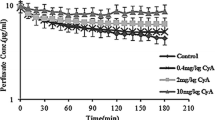Abstract
Anthracycline anticancer agents are widely used in the cancer chemotherapy for hepatocelluar carcinoma. However, accurate kinetic analyses of the hepatocellular uptake and efflux of the drugs have not been reported. We, therefore, investigated the hepatobiliary transport of epirubicin, an anthracycline derived antibiotic, after intravenous (i.v.) infusion in rats. The hepatic uptake mechanisms of epirubicin were also investigated in isolated rat hepatocytes. To analyze epirubicin levels in the biological samples, we used an HPLC-based method which has been validated for a kinetic study by suitable criteria. The uptake process of epirubicin by the hepatocytes revealed one saturable component, with a Km of 99.1 μg/mL and Vmax of 3.70 μg/min/106 cells. The initial uptake velocity of epirubicin was significantly inhibited in a temperature-dependent manner. The velocity was also reduced in the presence of metabolic inhibitors such as rotenone or carbonylcyanide-p-(trifluoromethoxy)-phenylhydrazone. Substrates for organic anion transporters such as bromosulfophthalein and taurocholate significantly inhibited the initial uptake velocity of epirubicin. We also attempted to determine the hepatobiliary transport of epirubicin after i.v. infusion in vivo. At steady-state after i.v. infusion of epirubicin (10–160 μg/min/kg), the drug was extensively accumulated in the liver, followed by excretion into bile. Furthermore, the CLbile,plasma and CLbile,liver decreased with a corresponding increase in the Css,plasma and Css,liver. In conclusion, present studies using isolated rat hepatocytes and in vivo i.v. infusion demonstrate that epirubicin is likely to be taken up into liver cells via organic anion transporting polypeptides, and that its biliary excretion might be mediated via specific transporters.






Similar content being viewed by others
References
Berchem, G.J., F. Ries, J. Hanfelt, C. Duhem, M. Keipes, C. Delagardelle, and M. Dicato. 1996. Epirubicin cardiotoxicity: a study comparing low- with high-dose-intensity weekly schedules. Supportive Care in Cancer 4: 308–312.
Danesi, R., F. Innocenti, S. Fogli, A. Gennari, E. Baldini, A.D. Paolo, B. Salvadori, G. Bocci, P.F. Conte, and M.D. Tacca. 2002. Pharmacokinetics and pharmacodynamics of combination chemotherapy with paclitaxel and epirubicin in breast cancer patients. British Journal of Clinical Pharmacology 10: 508–518.
Fujita, H., K. Ogawa, H. Tone, H. Iguchi, T. Shomura, and S. Murata. 1986. Pharmacokinetics of doxorubicin, (2″R)-4′-O-tetrahydropyranyl-adriamycin and aclarubicin. Japanese Journal of Antibiotics 39: 1321–1336.
Hu, X.F., A. Slater, D. Rischin, P. Kantharidis, J.D. Parkin, and J. Zalcberg. 1999. Induction of MDR1 gene expression by anthracycline analogues in a human drug resistant leukaemia cell line. British Journal of Cancer 79: 831–837.
Iga, T., D.L. Eaton, and C.D. Klaassen. 1979. Uptake of unconjugated bilirubin by isolated rat hepatocytes. American Journal of Physiology 10: 9–14.
Iguchi, H., Y. Seryu, T. Kiyosaki, S. Hori, H. Tone, and T. Oki. 1980. Studies on the absorption, excretion and distribution of aclacinomycin A: Absorption, excretion and distribution of 14C- or 3H-aclacinomycin A in mice, rats and rabbits. Japanese Journal of Antibiotics 33: 169–178.
Iwakiri, T., M. Okumura, M. Hidaka, Y. Kumagai, E. Ichihara, Y. Kawano, and K. Arimori. 2008. Inhibition of carrier-mediated uptake of epirubicin reduces cytotoxicity in primary culture of rat hepatocytes. Journal of Applied Toxicology 28: 329–336.
Lo, Y.L. 2000. Phospholipids as multidrug resistance modulators of the transport of epirubicin in human intestinal epithelial Caco-2 cell layers and everted gut sacs of rats. Biochemical Pharmacology 60: 1381–1390.
Lo, Y.L. 2003. Relationships between the hydrophilic-lipophilic balance values of pharmaceutical excipients and their multidrug resistance modulating effect in Caco-2 cells and rat intestines. Journal of Controlled Release 90: 37–48.
Minotti, G., P. Menna, E. Salvatorelli, G. Cairo, and L. Gianni. 2004. Anthracyclines: Molecular advances and pharmacologic developments in antitumor activity and cardiotoxicity. Pharmacological Reviews 56: 185–229.
Nagasawa, K., T. Natazuka, K. Chihara, F. Kitazawa, A. Tsumura, K. Takara, M. Nomiyama, N. Ohnishi, and T. Yokoyama. 1996. Transport mechanism of anthracycline derivatives in human leukemia cell lines: Uptake and efflux of pirarubicin in HL60 and pirarubicin-resistant HL60 cells. Cancer Chemotherapy and Pharmacology 37: 297–304.
Nagata, M., Y. Matsuo, M. Hidaka, Y. Kawano, M. Okumura, J. Tokunaga, N. Takamura, and K. Arimori. 2008. Effect of acute hepatic failure on epirubicin pharmacokinetics after intrahepatic arterial injection in rats. Biological and Pharmaceutical Bulletin 31: 493–496.
Peng, X., B. Chen, C.C. Lim, and D.B. Sawyer. 1993. The cardiotoxicology of anthracycline chemotherapeutics: Translating molecular mechanism into preventative medicine. Molecular Interventions 5: 163–171.
Robert, J. 1993. Epirubicin. Clinical pharmacology and dose-effect relationship. Drugs 45(Suppl. 2): 20–30.
Shin, D.H., S.H. Park, O.-S. Kwon, C.-U. Park, K. Han, and Y.B. Chung. 2013. Validation of high-performance liqid chromatography method to determine epirubicin and its pharmacokinetics after intravenous bolus administration in rats. Journal of Pharmaceutical Investigation 43: 243–249.
Yamazaki, M., H. Suzuki, Y. Sugiyama, T. Iga, and M. Hanano. 1992. Uptake of organic anions by isolated rat hepatocytes: A classification in terms of ATP-dependency. Journal of Hepatology 14: 41–47.
Yamazaki, M., H. Suzuki, M. Hanano, T. Tokui, T. Komai, and Y. Sugiyama. 1993. Na+-independent multispecific anion transporter mediates active transport of pravastatin into rat liver. American Journal of Physiology 264: G36–G44.
Yamazaki, M., H. Suzuki, and Y. Sugiyama. 1996. Recent advances in carrier-mediated hepatic uptake and biliary excretion of xenobiotics. Pharmaceutical Research 13: 497–513.
Yoo, B.I., K.B. Ahan, M.H. Kang, D.C. Moon, O.S. Kwon, H.S. Lee, J.S. Ryu, T.Y. Kim, S. Song, and Y.B. Chung. 2005. HPLC analysis and pharmacokinetic characteristics of 11-hydroxyaclacinomycin X (ID-6105), a novel anthracycline, in rats and beagle dogs. Biological and Pharmaceutical Bulletin 28: 88–693.
Acknowledgments
This work was supported by the research grant of the Chungbuk National University in 2012.
Author information
Authors and Affiliations
Corresponding author
Rights and permissions
About this article
Cite this article
Shin, D.H., Park, S.H., Jeong, S.W. et al. Hepatic uptake of epirubicin by isolated rat hepatocytes and its biliary excretion after intravenous infusion in rats. Arch. Pharm. Res. 37, 1599–1606 (2014). https://doi.org/10.1007/s12272-014-0475-5
Received:
Accepted:
Published:
Issue Date:
DOI: https://doi.org/10.1007/s12272-014-0475-5




